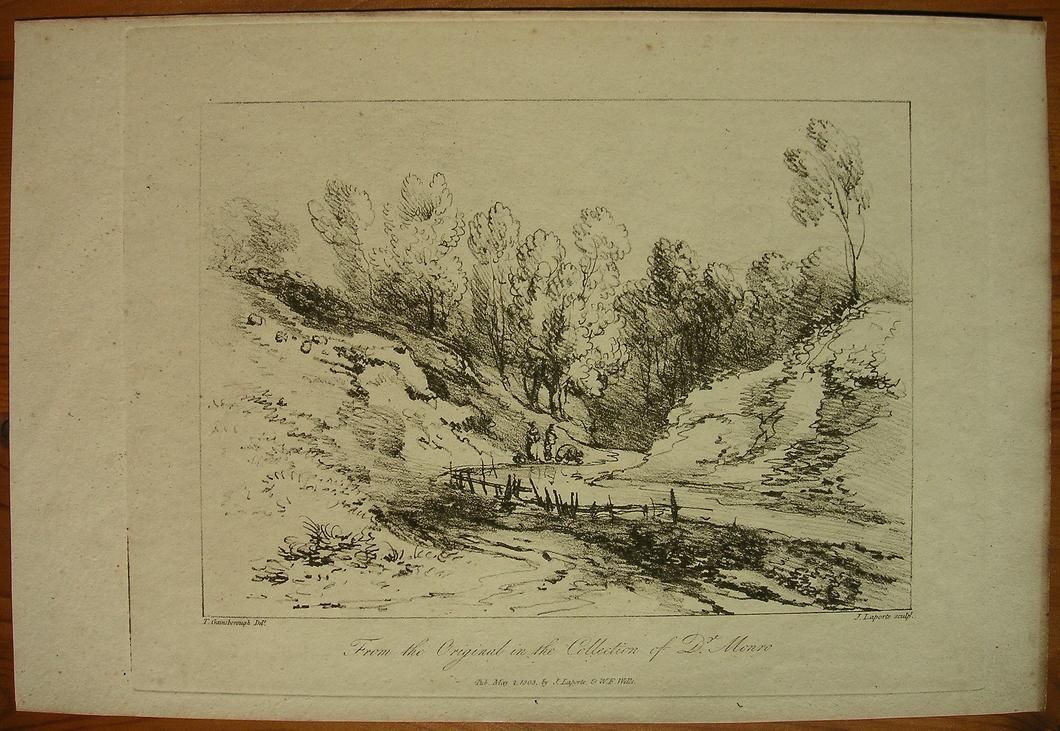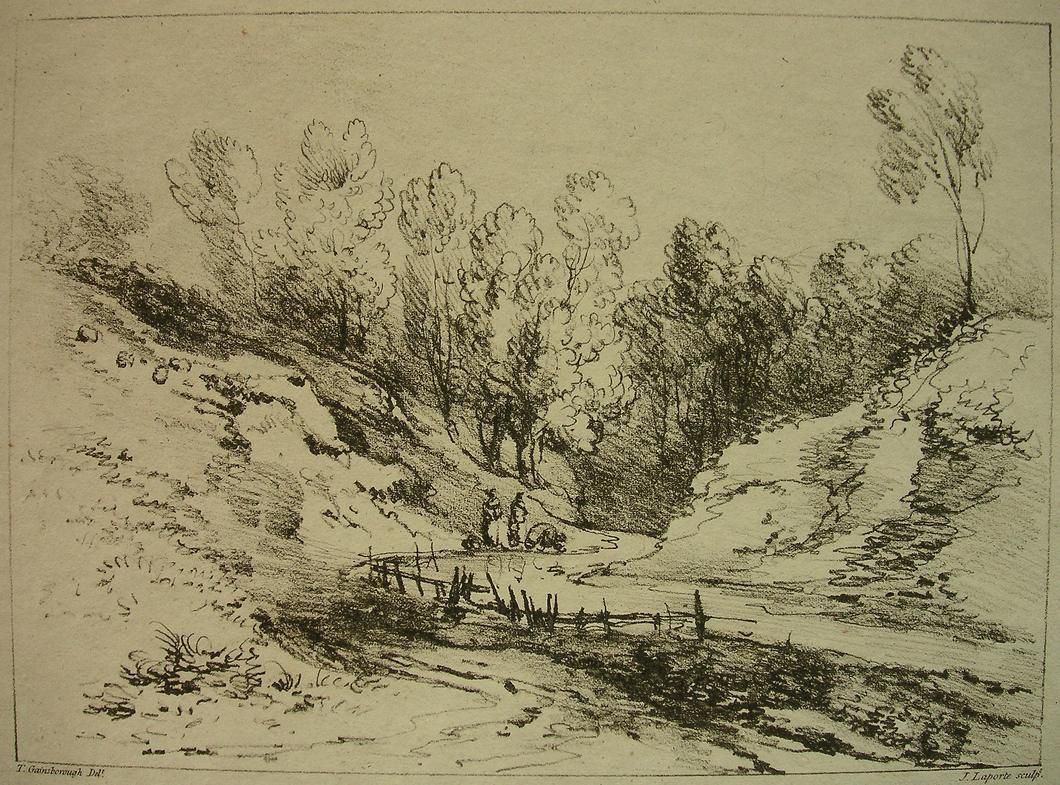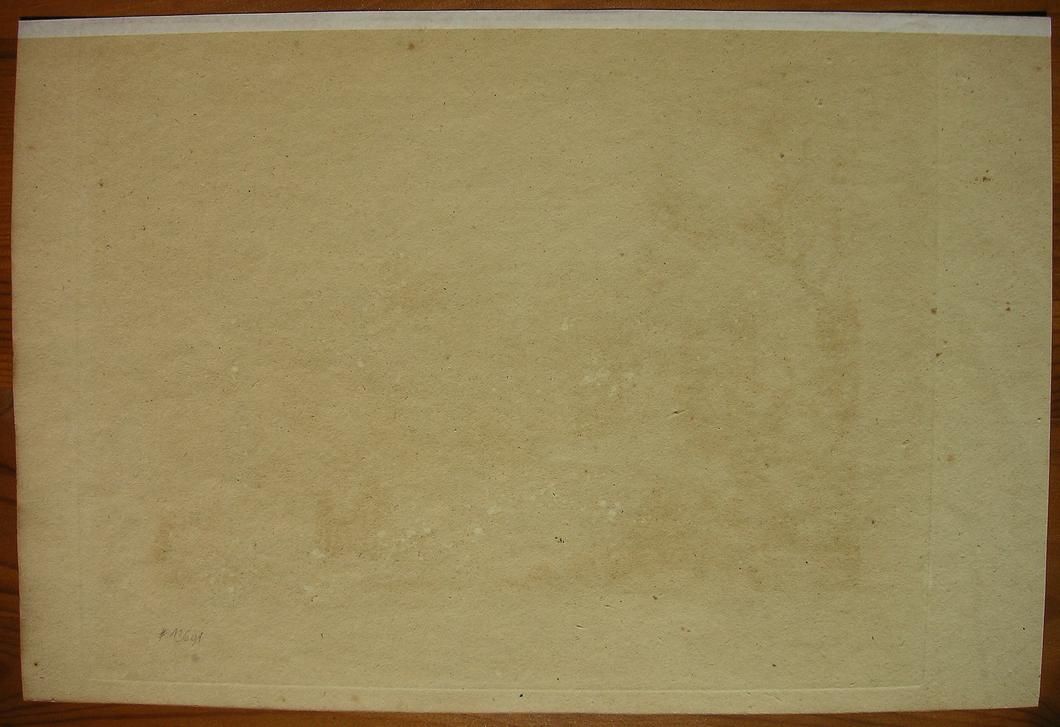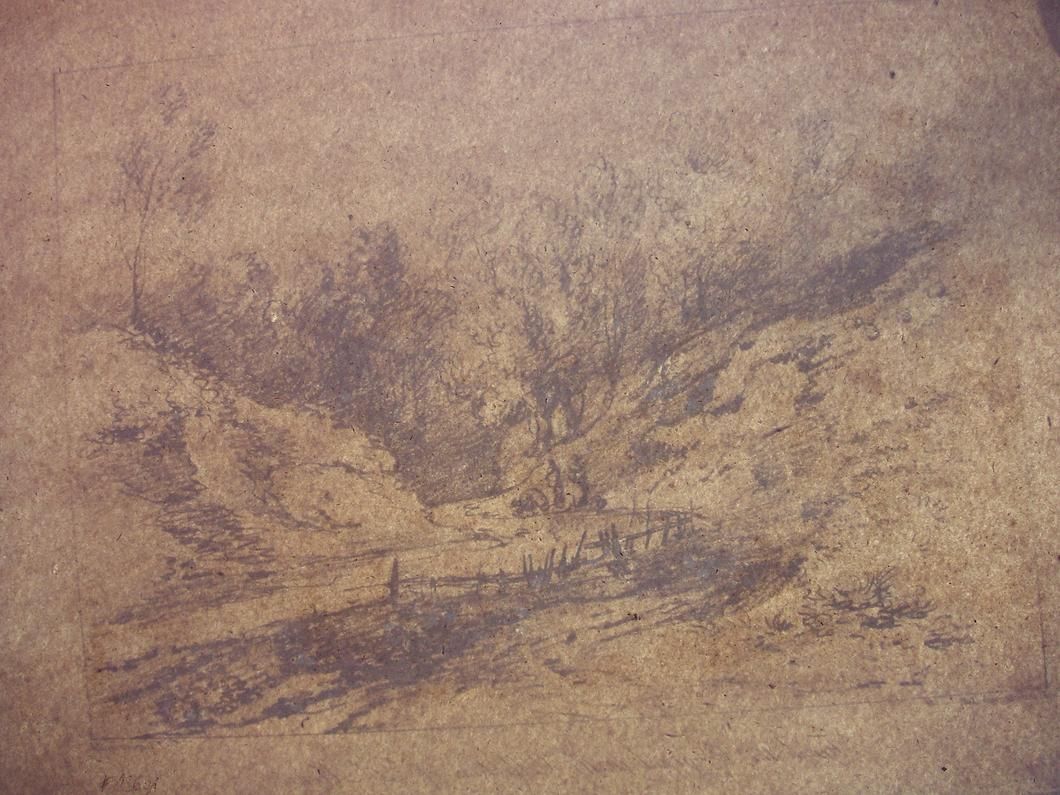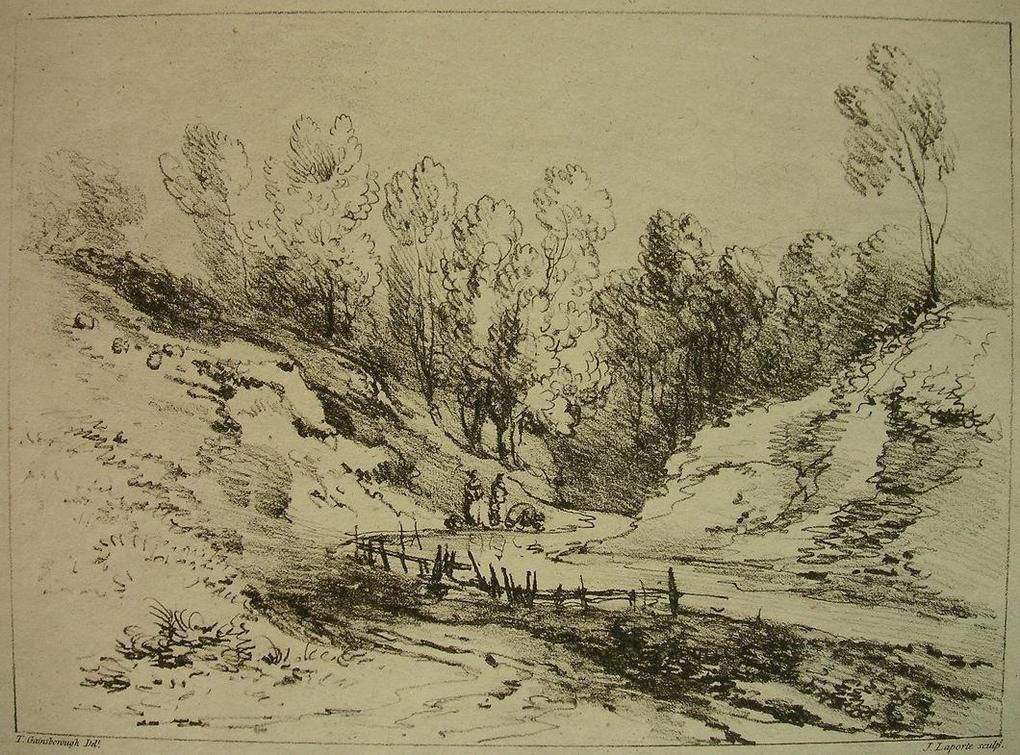
`T. Gainsborough R.A. del.t; J. Laporte sculp.t´
`Pub. May 2. 1803 by J. Laporte & W. F. Wells´
Blatt/ sheet: 25,9 x 38,2 cm
Platte/ plate: 24,5 x 31,5 cm
Englische Landschaft, nach Thomas Gainsborough (1727-1788).
Vernis mou (Weichgrundätzung) von John Laporte (1761-1839) nach
Thomas Gainsborough (1727-1788), signiert und datiert, ohne Ort,
(London), 1803.
Ansicht aus 'A Collection of prints, illustrative of English Scenery; From
the Drawings and Sketches of Gainsborough' von John Laporte und
William Frederick Wells (1764-1836), (die Tafeln dat. von 1802-1805),
London, um 1805 [EA, 72 Tafeln], die spätere Ausgabe von 1819 hat
nur 60 Tafeln; dieses Blatt aus der Ausgabe 1819.
Die Weichgrundätzung (Vernis mou) fand insbesondere in der englischen Landschaftsdarstellung
des ausgehenden 18. Jh. und des frühen 19. Jh. (um 1770-1820) Anwendung. Sie eignete sich
hervorragend dazu die Weichheit von Zeichnungen zu imitieren, von Thomas Gainsborough,
John Sell Cotman und Thomas Girtin jedoch ist bekannt, dass sie die Technik auch direkt
benutzten, ohne Vorlage. Die Weichgrundätzung wurde von der Lithographie abgelöst,
mit der sie häufig verwechselt wird, ebenso wie mit der Radierung in Kreidemanier.
Erst Jahrzehnte später erlebte die Weichgrundätzung durch Edgar Degas, Camille
Pissarro und Mary Cassatt eine Wiederauferstehung.
Referenz:
Lowndes II, S.854 (73 Tafeln, datiert 1802);
Abbey, Life 203 und Tooley 231 (bd. 60 Tafeln, Ausgabe Boydell, 1819);
G. N. Ray, The Illustrator and the Book, (1976), S. 48f., Nr. 74;
Getty, GRI Library Catalog, OCLC Nr. 81387989, 72 Tafeln (1805?);
Getty, GRI Library Catalog, OCLC Nr. 9369595, 60 Tafeln (1819).
Ausgezeichneter Abdruck auf ecru-farbenem Velin mit Rand, oben schmal.
Das Blatt leicht gebräunt, vereinzelt fleckig und stockfleckig, Montagerest
verso, sonst sehr schön.
Photos unten sowie oben li. (HR).
English landscape, after Thomas Gainsborough (1727-1788).
Soft-ground etching (Vernis mou) by John Laporte (1761-1839) after
Thomas Gainsborough (1727-1788), signed and dated, no place,
(London), 1803.
View from 'A Collection of prints, illustrative of English Scenery; From
the Drawings and Sketches of Gainsborough' by John Laporte and
William Frederick Wells (1764-1836), (plates dated from 1802-1805),
London, c.1805 [1. Ed., 72 plts.], the later Edition from 1819 with
60 plts. only; this plate here from the 1819 Edition.
During the late 18th and early 19th centuries (c. 1770-1830), soft-ground etching, or vernis mou,
became current. It was primarily a reproductive technique but was used also by the 18th-century
English artists Thomas Gainsborough, John Sell Cotman and Thomas Girtin for original designs,
mainly landscapes. It was replaced by lithography, with which it is often confused, as well as
with etching in chalk manner. In the late 19th century, Edgar Degas, Camille Pissarro, and
Mary Cassatt used the then moribund technique for artistic ends, and their work fostered
a revival in the 20th century.
Reference:
Lowndes II, p.854 (73 pl., date 1802);
Abbey, Life 203 and Tooley 231 (both 60 pl., Boydell Ed., 1819);
G. N. Ray, The Illustrator and the Book, (1976), p. 48f., No. 74;
Getty, GRI Library Catalog, OCLC No. 81387989, 72 pl. (1805?);
Getty, GRI Library Catalog, OCLC No. 9369595, 60 pl. (1819).
Excellent impression on ecru-coloured wove paper with margins around,
narrow at top. Sheet with minor browning, soiling and foxing. Traces of
former mounting on verso, else nice.
Photos below and top left. (HR)
`Pub. May 2. 1803 by J. Laporte & W. F. Wells´
Blatt/ sheet: 25,9 x 38,2 cm
Platte/ plate: 24,5 x 31,5 cm
Englische Landschaft, nach Thomas Gainsborough (1727-1788).
Vernis mou (Weichgrundätzung) von John Laporte (1761-1839) nach
Thomas Gainsborough (1727-1788), signiert und datiert, ohne Ort,
(London), 1803.
Ansicht aus 'A Collection of prints, illustrative of English Scenery; From
the Drawings and Sketches of Gainsborough' von John Laporte und
William Frederick Wells (1764-1836), (die Tafeln dat. von 1802-1805),
London, um 1805 [EA, 72 Tafeln], die spätere Ausgabe von 1819 hat
nur 60 Tafeln; dieses Blatt aus der Ausgabe 1819.
Die Weichgrundätzung (Vernis mou) fand insbesondere in der englischen Landschaftsdarstellung
des ausgehenden 18. Jh. und des frühen 19. Jh. (um 1770-1820) Anwendung. Sie eignete sich
hervorragend dazu die Weichheit von Zeichnungen zu imitieren, von Thomas Gainsborough,
John Sell Cotman und Thomas Girtin jedoch ist bekannt, dass sie die Technik auch direkt
benutzten, ohne Vorlage. Die Weichgrundätzung wurde von der Lithographie abgelöst,
mit der sie häufig verwechselt wird, ebenso wie mit der Radierung in Kreidemanier.
Erst Jahrzehnte später erlebte die Weichgrundätzung durch Edgar Degas, Camille
Pissarro und Mary Cassatt eine Wiederauferstehung.
Referenz:
Lowndes II, S.854 (73 Tafeln, datiert 1802);
Abbey, Life 203 und Tooley 231 (bd. 60 Tafeln, Ausgabe Boydell, 1819);
G. N. Ray, The Illustrator and the Book, (1976), S. 48f., Nr. 74;
Getty, GRI Library Catalog, OCLC Nr. 81387989, 72 Tafeln (1805?);
Getty, GRI Library Catalog, OCLC Nr. 9369595, 60 Tafeln (1819).
Ausgezeichneter Abdruck auf ecru-farbenem Velin mit Rand, oben schmal.
Das Blatt leicht gebräunt, vereinzelt fleckig und stockfleckig, Montagerest
verso, sonst sehr schön.
Photos unten sowie oben li. (HR).
English landscape, after Thomas Gainsborough (1727-1788).
Soft-ground etching (Vernis mou) by John Laporte (1761-1839) after
Thomas Gainsborough (1727-1788), signed and dated, no place,
(London), 1803.
View from 'A Collection of prints, illustrative of English Scenery; From
the Drawings and Sketches of Gainsborough' by John Laporte and
William Frederick Wells (1764-1836), (plates dated from 1802-1805),
London, c.1805 [1. Ed., 72 plts.], the later Edition from 1819 with
60 plts. only; this plate here from the 1819 Edition.
During the late 18th and early 19th centuries (c. 1770-1830), soft-ground etching, or vernis mou,
became current. It was primarily a reproductive technique but was used also by the 18th-century
English artists Thomas Gainsborough, John Sell Cotman and Thomas Girtin for original designs,
mainly landscapes. It was replaced by lithography, with which it is often confused, as well as
with etching in chalk manner. In the late 19th century, Edgar Degas, Camille Pissarro, and
Mary Cassatt used the then moribund technique for artistic ends, and their work fostered
a revival in the 20th century.
Reference:
Lowndes II, p.854 (73 pl., date 1802);
Abbey, Life 203 and Tooley 231 (both 60 pl., Boydell Ed., 1819);
G. N. Ray, The Illustrator and the Book, (1976), p. 48f., No. 74;
Getty, GRI Library Catalog, OCLC No. 81387989, 72 pl. (1805?);
Getty, GRI Library Catalog, OCLC No. 9369595, 60 pl. (1819).
Excellent impression on ecru-coloured wove paper with margins around,
narrow at top. Sheet with minor browning, soiling and foxing. Traces of
former mounting on verso, else nice.
Photos below and top left. (HR)
Rechtliche Informationen s.u.
